Relationship between Business and Human Resource Strategies
VerifiedAdded on 2023/01/12
|15
|4014
|94
AI Summary
This report discusses the relationship between business strategy and human resource strategy, focusing on the importance of vertical alignment and horizontal integration. It also explores HR practices of performance management and reward. Recommendations are provided for improving the performance management system and employment relationship.
Contribute Materials
Your contribution can guide someone’s learning journey. Share your
documents today.
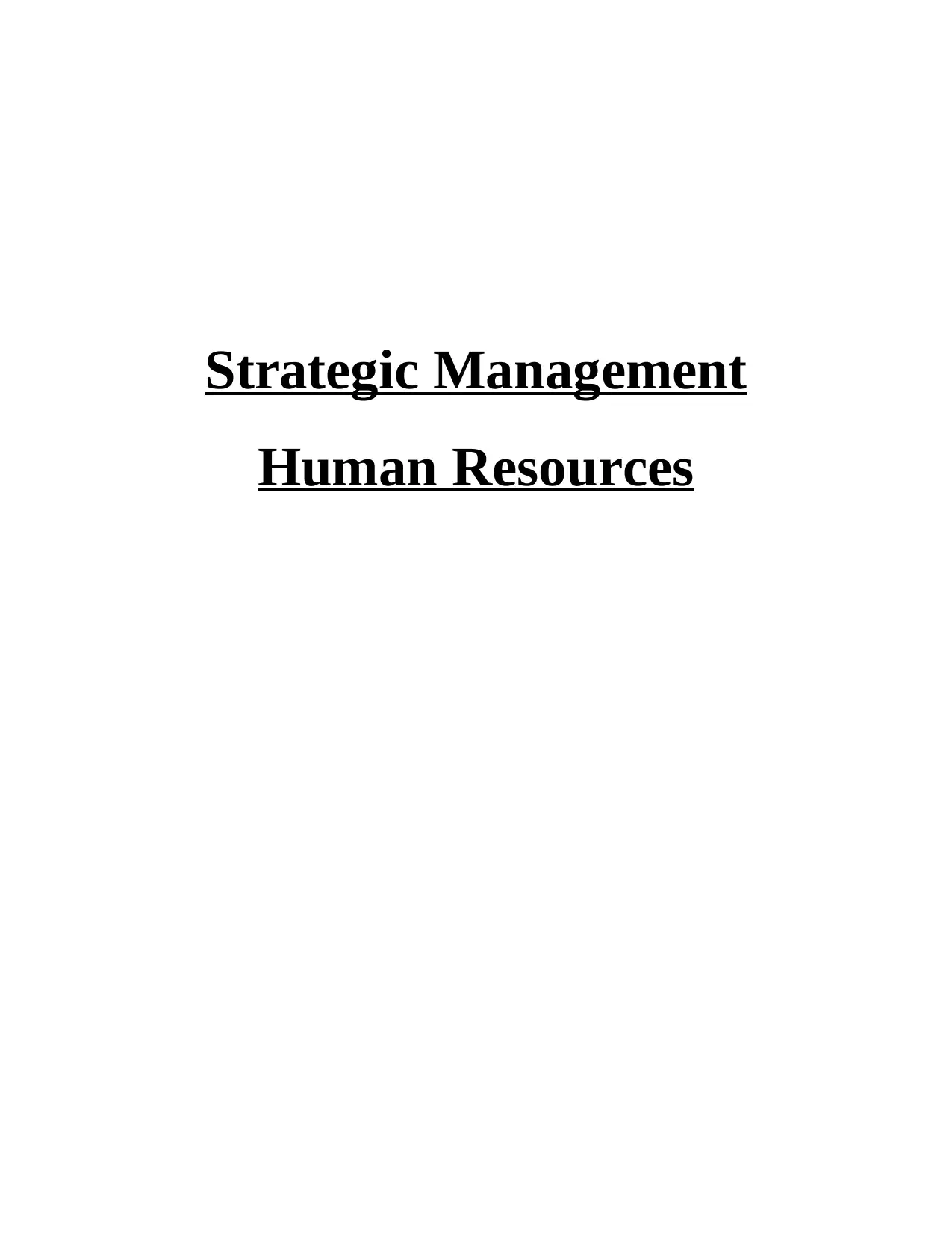
Strategic Management
Human Resources
Human Resources
Secure Best Marks with AI Grader
Need help grading? Try our AI Grader for instant feedback on your assignments.
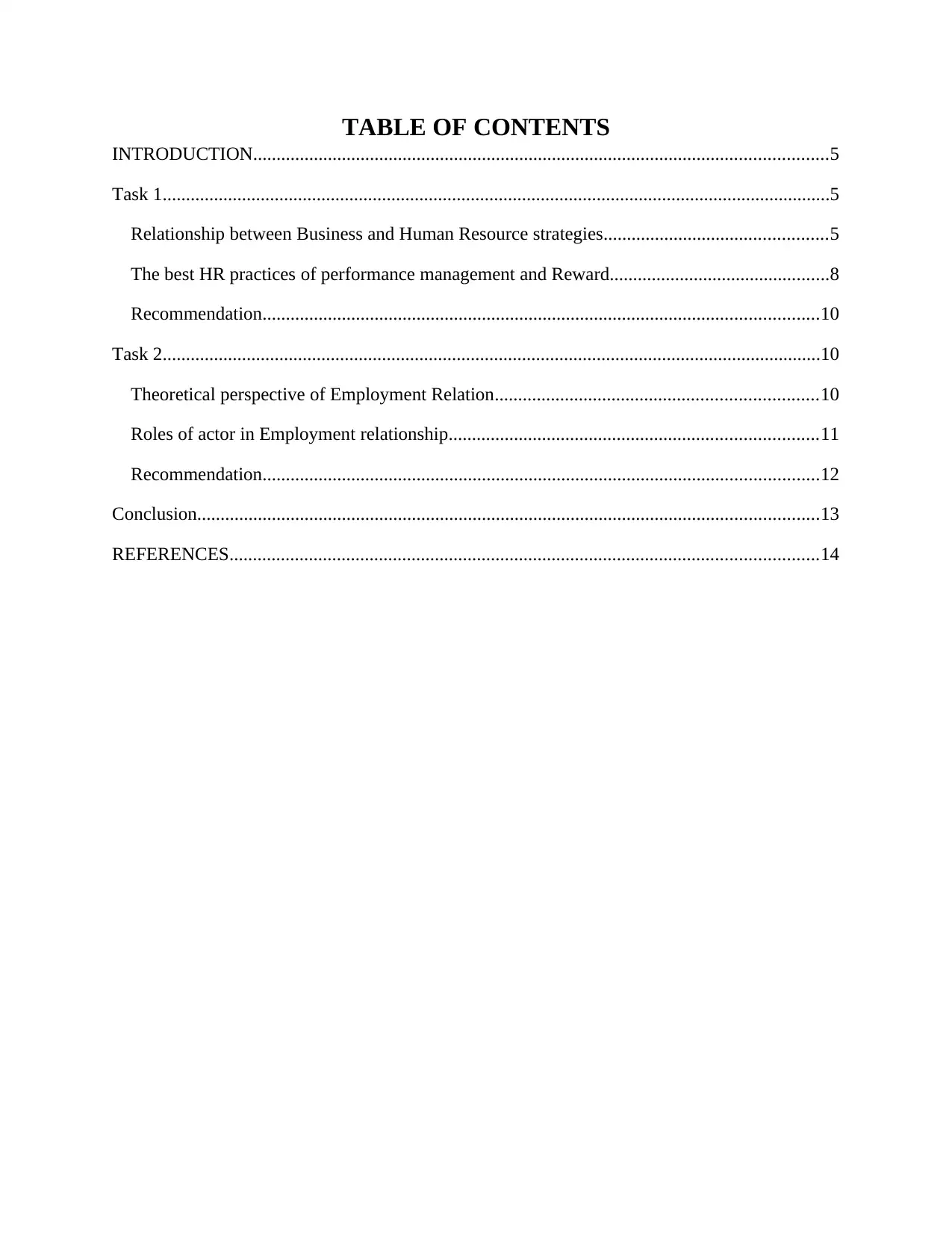
TABLE OF CONTENTS
INTRODUCTION...........................................................................................................................5
Task 1...............................................................................................................................................5
Relationship between Business and Human Resource strategies................................................5
The best HR practices of performance management and Reward...............................................8
Recommendation.......................................................................................................................10
Task 2.............................................................................................................................................10
Theoretical perspective of Employment Relation.....................................................................10
Roles of actor in Employment relationship...............................................................................11
Recommendation.......................................................................................................................12
Conclusion.....................................................................................................................................13
REFERENCES..............................................................................................................................14
INTRODUCTION...........................................................................................................................5
Task 1...............................................................................................................................................5
Relationship between Business and Human Resource strategies................................................5
The best HR practices of performance management and Reward...............................................8
Recommendation.......................................................................................................................10
Task 2.............................................................................................................................................10
Theoretical perspective of Employment Relation.....................................................................10
Roles of actor in Employment relationship...............................................................................11
Recommendation.......................................................................................................................12
Conclusion.....................................................................................................................................13
REFERENCES..............................................................................................................................14
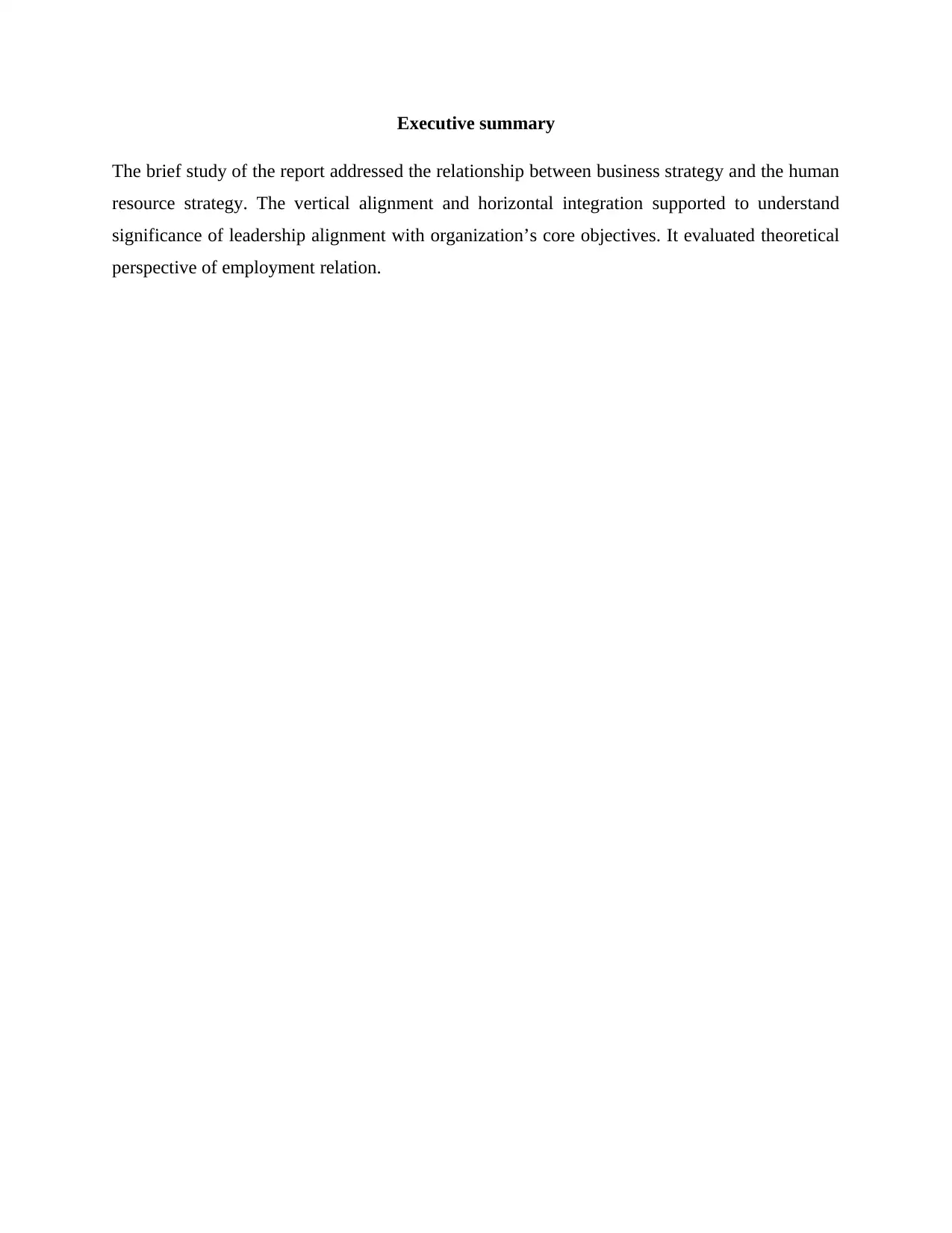
Executive summary
The brief study of the report addressed the relationship between business strategy and the human
resource strategy. The vertical alignment and horizontal integration supported to understand
significance of leadership alignment with organization’s core objectives. It evaluated theoretical
perspective of employment relation.
The brief study of the report addressed the relationship between business strategy and the human
resource strategy. The vertical alignment and horizontal integration supported to understand
significance of leadership alignment with organization’s core objectives. It evaluated theoretical
perspective of employment relation.
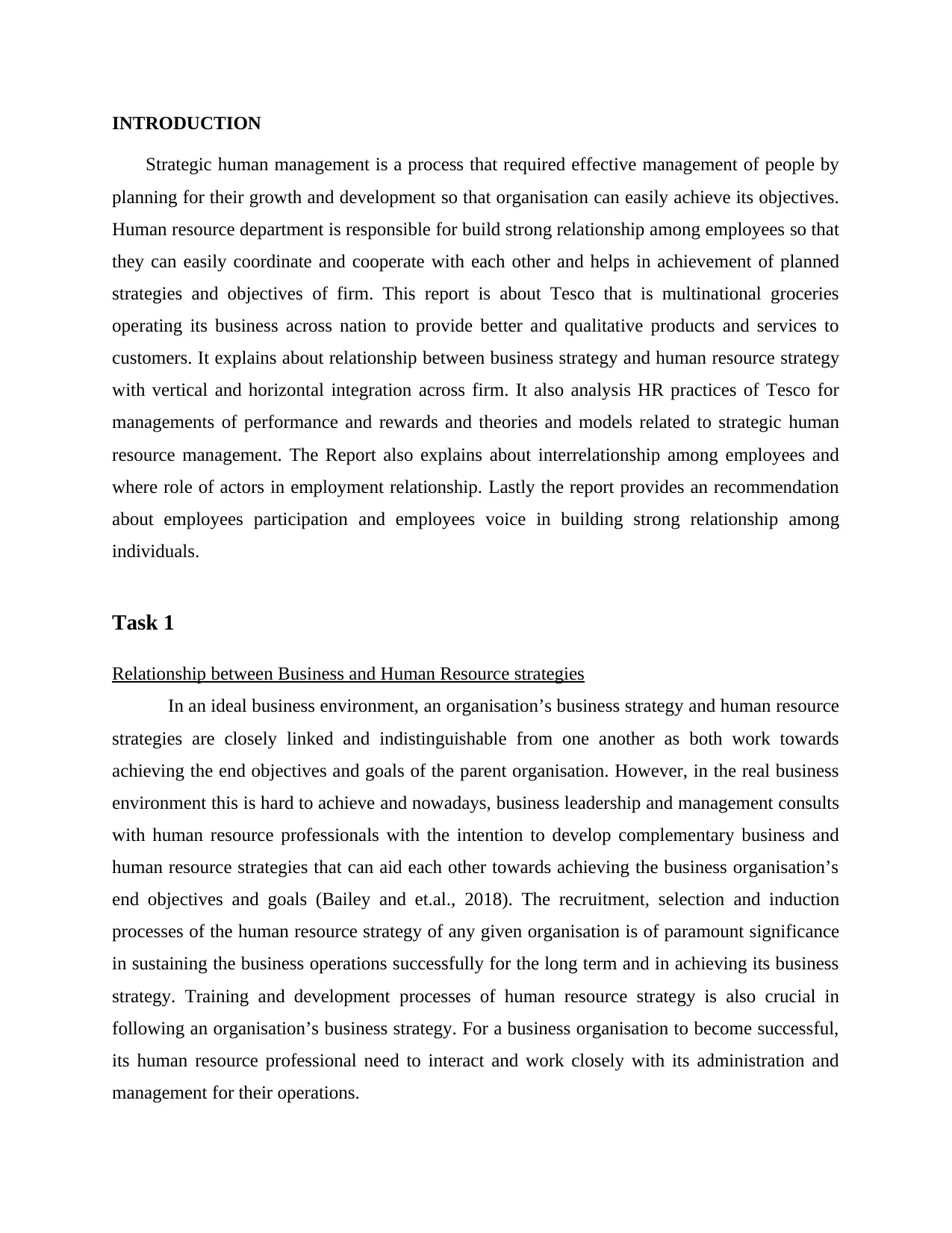
INTRODUCTION
Strategic human management is a process that required effective management of people by
planning for their growth and development so that organisation can easily achieve its objectives.
Human resource department is responsible for build strong relationship among employees so that
they can easily coordinate and cooperate with each other and helps in achievement of planned
strategies and objectives of firm. This report is about Tesco that is multinational groceries
operating its business across nation to provide better and qualitative products and services to
customers. It explains about relationship between business strategy and human resource strategy
with vertical and horizontal integration across firm. It also analysis HR practices of Tesco for
managements of performance and rewards and theories and models related to strategic human
resource management. The Report also explains about interrelationship among employees and
where role of actors in employment relationship. Lastly the report provides an recommendation
about employees participation and employees voice in building strong relationship among
individuals.
Task 1
Relationship between Business and Human Resource strategies
In an ideal business environment, an organisation’s business strategy and human resource
strategies are closely linked and indistinguishable from one another as both work towards
achieving the end objectives and goals of the parent organisation. However, in the real business
environment this is hard to achieve and nowadays, business leadership and management consults
with human resource professionals with the intention to develop complementary business and
human resource strategies that can aid each other towards achieving the business organisation’s
end objectives and goals (Bailey and et.al., 2018). The recruitment, selection and induction
processes of the human resource strategy of any given organisation is of paramount significance
in sustaining the business operations successfully for the long term and in achieving its business
strategy. Training and development processes of human resource strategy is also crucial in
following an organisation’s business strategy. For a business organisation to become successful,
its human resource professional need to interact and work closely with its administration and
management for their operations.
Strategic human management is a process that required effective management of people by
planning for their growth and development so that organisation can easily achieve its objectives.
Human resource department is responsible for build strong relationship among employees so that
they can easily coordinate and cooperate with each other and helps in achievement of planned
strategies and objectives of firm. This report is about Tesco that is multinational groceries
operating its business across nation to provide better and qualitative products and services to
customers. It explains about relationship between business strategy and human resource strategy
with vertical and horizontal integration across firm. It also analysis HR practices of Tesco for
managements of performance and rewards and theories and models related to strategic human
resource management. The Report also explains about interrelationship among employees and
where role of actors in employment relationship. Lastly the report provides an recommendation
about employees participation and employees voice in building strong relationship among
individuals.
Task 1
Relationship between Business and Human Resource strategies
In an ideal business environment, an organisation’s business strategy and human resource
strategies are closely linked and indistinguishable from one another as both work towards
achieving the end objectives and goals of the parent organisation. However, in the real business
environment this is hard to achieve and nowadays, business leadership and management consults
with human resource professionals with the intention to develop complementary business and
human resource strategies that can aid each other towards achieving the business organisation’s
end objectives and goals (Bailey and et.al., 2018). The recruitment, selection and induction
processes of the human resource strategy of any given organisation is of paramount significance
in sustaining the business operations successfully for the long term and in achieving its business
strategy. Training and development processes of human resource strategy is also crucial in
following an organisation’s business strategy. For a business organisation to become successful,
its human resource professional need to interact and work closely with its administration and
management for their operations.
Secure Best Marks with AI Grader
Need help grading? Try our AI Grader for instant feedback on your assignments.
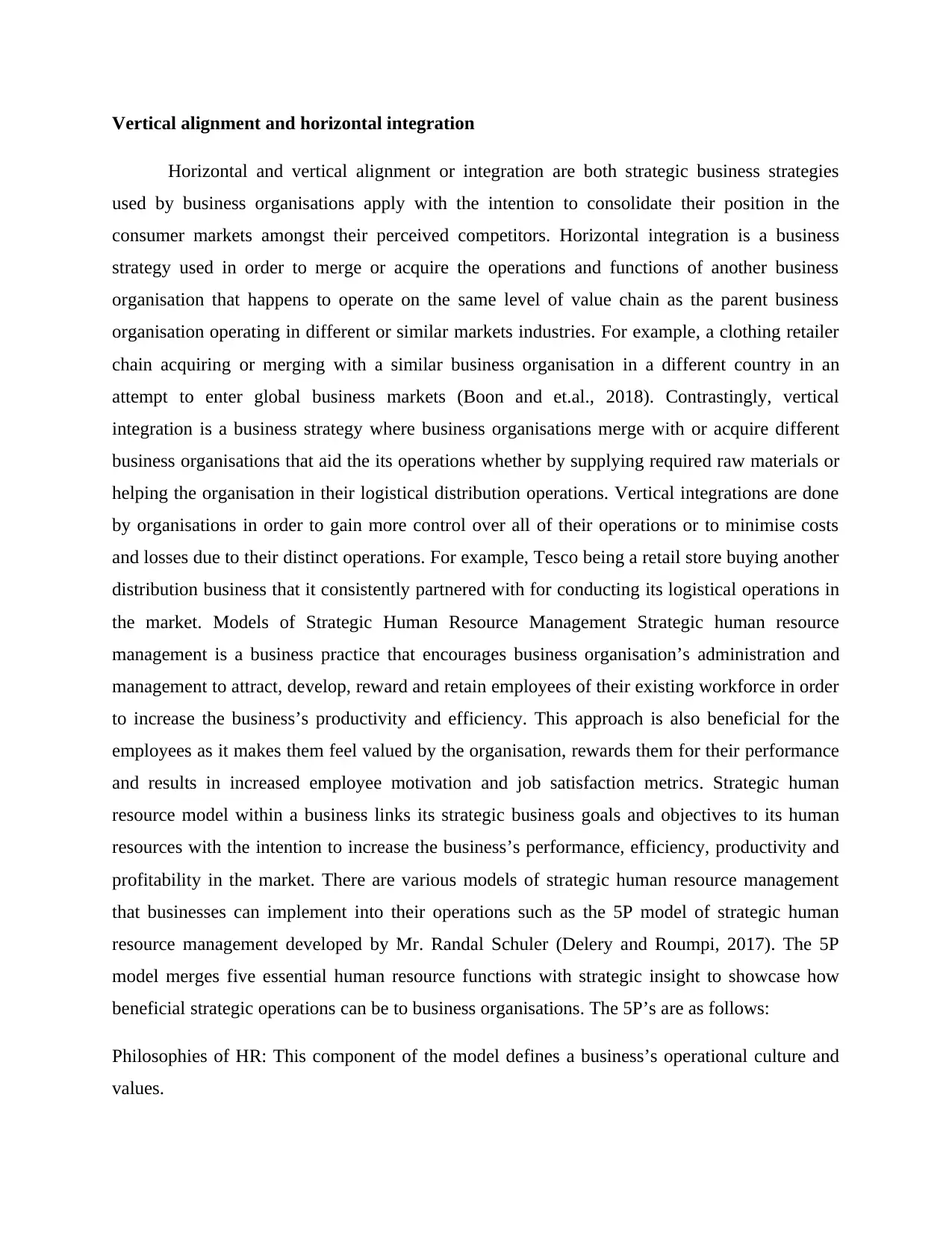
Vertical alignment and horizontal integration
Horizontal and vertical alignment or integration are both strategic business strategies
used by business organisations apply with the intention to consolidate their position in the
consumer markets amongst their perceived competitors. Horizontal integration is a business
strategy used in order to merge or acquire the operations and functions of another business
organisation that happens to operate on the same level of value chain as the parent business
organisation operating in different or similar markets industries. For example, a clothing retailer
chain acquiring or merging with a similar business organisation in a different country in an
attempt to enter global business markets (Boon and et.al., 2018). Contrastingly, vertical
integration is a business strategy where business organisations merge with or acquire different
business organisations that aid the its operations whether by supplying required raw materials or
helping the organisation in their logistical distribution operations. Vertical integrations are done
by organisations in order to gain more control over all of their operations or to minimise costs
and losses due to their distinct operations. For example, Tesco being a retail store buying another
distribution business that it consistently partnered with for conducting its logistical operations in
the market. Models of Strategic Human Resource Management Strategic human resource
management is a business practice that encourages business organisation’s administration and
management to attract, develop, reward and retain employees of their existing workforce in order
to increase the business’s productivity and efficiency. This approach is also beneficial for the
employees as it makes them feel valued by the organisation, rewards them for their performance
and results in increased employee motivation and job satisfaction metrics. Strategic human
resource model within a business links its strategic business goals and objectives to its human
resources with the intention to increase the business’s performance, efficiency, productivity and
profitability in the market. There are various models of strategic human resource management
that businesses can implement into their operations such as the 5P model of strategic human
resource management developed by Mr. Randal Schuler (Delery and Roumpi, 2017). The 5P
model merges five essential human resource functions with strategic insight to showcase how
beneficial strategic operations can be to business organisations. The 5P’s are as follows:
Philosophies of HR: This component of the model defines a business’s operational culture and
values.
Horizontal and vertical alignment or integration are both strategic business strategies
used by business organisations apply with the intention to consolidate their position in the
consumer markets amongst their perceived competitors. Horizontal integration is a business
strategy used in order to merge or acquire the operations and functions of another business
organisation that happens to operate on the same level of value chain as the parent business
organisation operating in different or similar markets industries. For example, a clothing retailer
chain acquiring or merging with a similar business organisation in a different country in an
attempt to enter global business markets (Boon and et.al., 2018). Contrastingly, vertical
integration is a business strategy where business organisations merge with or acquire different
business organisations that aid the its operations whether by supplying required raw materials or
helping the organisation in their logistical distribution operations. Vertical integrations are done
by organisations in order to gain more control over all of their operations or to minimise costs
and losses due to their distinct operations. For example, Tesco being a retail store buying another
distribution business that it consistently partnered with for conducting its logistical operations in
the market. Models of Strategic Human Resource Management Strategic human resource
management is a business practice that encourages business organisation’s administration and
management to attract, develop, reward and retain employees of their existing workforce in order
to increase the business’s productivity and efficiency. This approach is also beneficial for the
employees as it makes them feel valued by the organisation, rewards them for their performance
and results in increased employee motivation and job satisfaction metrics. Strategic human
resource model within a business links its strategic business goals and objectives to its human
resources with the intention to increase the business’s performance, efficiency, productivity and
profitability in the market. There are various models of strategic human resource management
that businesses can implement into their operations such as the 5P model of strategic human
resource management developed by Mr. Randal Schuler (Delery and Roumpi, 2017). The 5P
model merges five essential human resource functions with strategic insight to showcase how
beneficial strategic operations can be to business organisations. The 5P’s are as follows:
Philosophies of HR: This component of the model defines a business’s operational culture and
values.
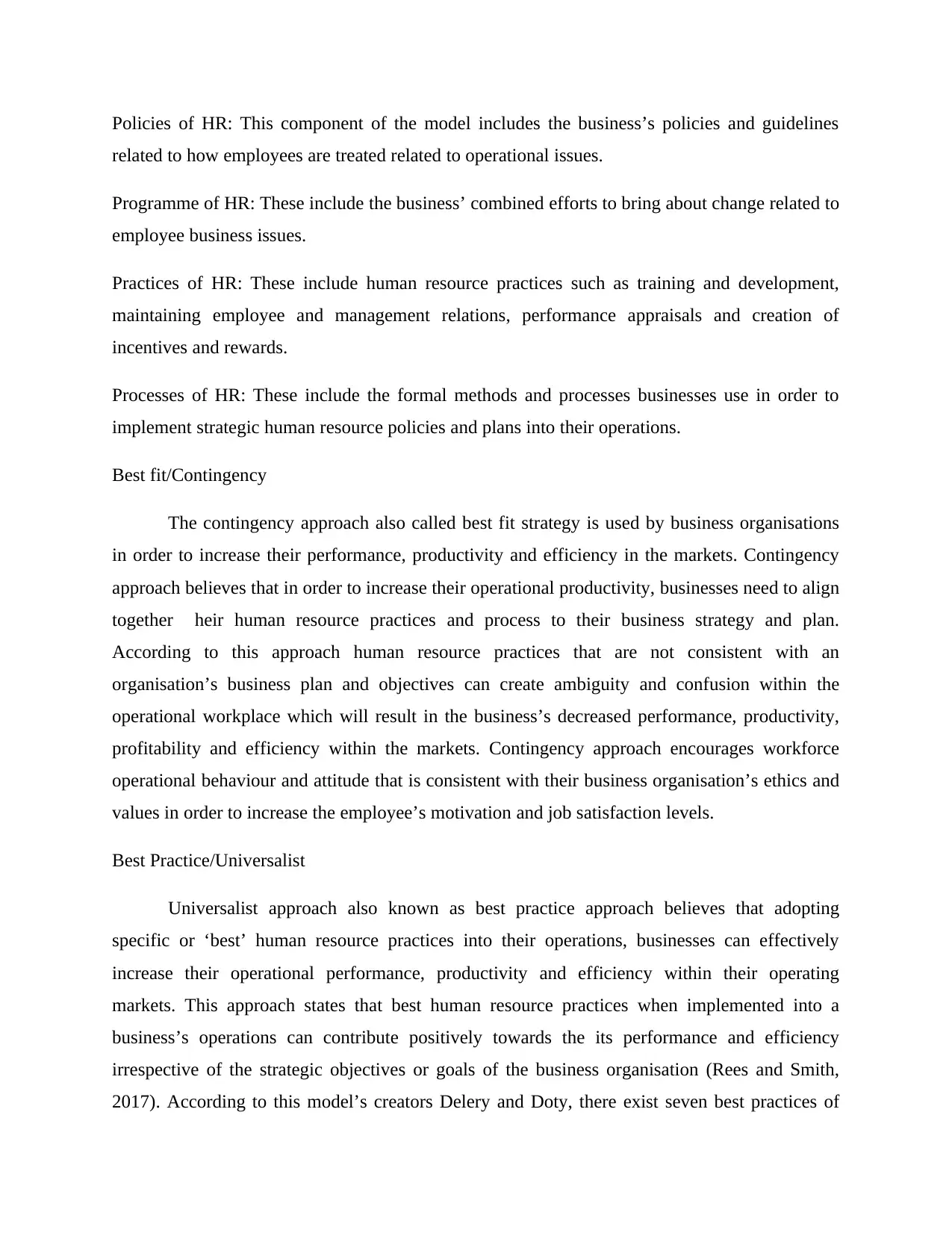
Policies of HR: This component of the model includes the business’s policies and guidelines
related to how employees are treated related to operational issues.
Programme of HR: These include the business’ combined efforts to bring about change related to
employee business issues.
Practices of HR: These include human resource practices such as training and development,
maintaining employee and management relations, performance appraisals and creation of
incentives and rewards.
Processes of HR: These include the formal methods and processes businesses use in order to
implement strategic human resource policies and plans into their operations.
Best fit/Contingency
The contingency approach also called best fit strategy is used by business organisations
in order to increase their performance, productivity and efficiency in the markets. Contingency
approach believes that in order to increase their operational productivity, businesses need to align
together heir human resource practices and process to their business strategy and plan.
According to this approach human resource practices that are not consistent with an
organisation’s business plan and objectives can create ambiguity and confusion within the
operational workplace which will result in the business’s decreased performance, productivity,
profitability and efficiency within the markets. Contingency approach encourages workforce
operational behaviour and attitude that is consistent with their business organisation’s ethics and
values in order to increase the employee’s motivation and job satisfaction levels.
Best Practice/Universalist
Universalist approach also known as best practice approach believes that adopting
specific or ‘best’ human resource practices into their operations, businesses can effectively
increase their operational performance, productivity and efficiency within their operating
markets. This approach states that best human resource practices when implemented into a
business’s operations can contribute positively towards the its performance and efficiency
irrespective of the strategic objectives or goals of the business organisation (Rees and Smith,
2017). According to this model’s creators Delery and Doty, there exist seven best practices of
related to how employees are treated related to operational issues.
Programme of HR: These include the business’ combined efforts to bring about change related to
employee business issues.
Practices of HR: These include human resource practices such as training and development,
maintaining employee and management relations, performance appraisals and creation of
incentives and rewards.
Processes of HR: These include the formal methods and processes businesses use in order to
implement strategic human resource policies and plans into their operations.
Best fit/Contingency
The contingency approach also called best fit strategy is used by business organisations
in order to increase their performance, productivity and efficiency in the markets. Contingency
approach believes that in order to increase their operational productivity, businesses need to align
together heir human resource practices and process to their business strategy and plan.
According to this approach human resource practices that are not consistent with an
organisation’s business plan and objectives can create ambiguity and confusion within the
operational workplace which will result in the business’s decreased performance, productivity,
profitability and efficiency within the markets. Contingency approach encourages workforce
operational behaviour and attitude that is consistent with their business organisation’s ethics and
values in order to increase the employee’s motivation and job satisfaction levels.
Best Practice/Universalist
Universalist approach also known as best practice approach believes that adopting
specific or ‘best’ human resource practices into their operations, businesses can effectively
increase their operational performance, productivity and efficiency within their operating
markets. This approach states that best human resource practices when implemented into a
business’s operations can contribute positively towards the its performance and efficiency
irrespective of the strategic objectives or goals of the business organisation (Rees and Smith,
2017). According to this model’s creators Delery and Doty, there exist seven best practices of
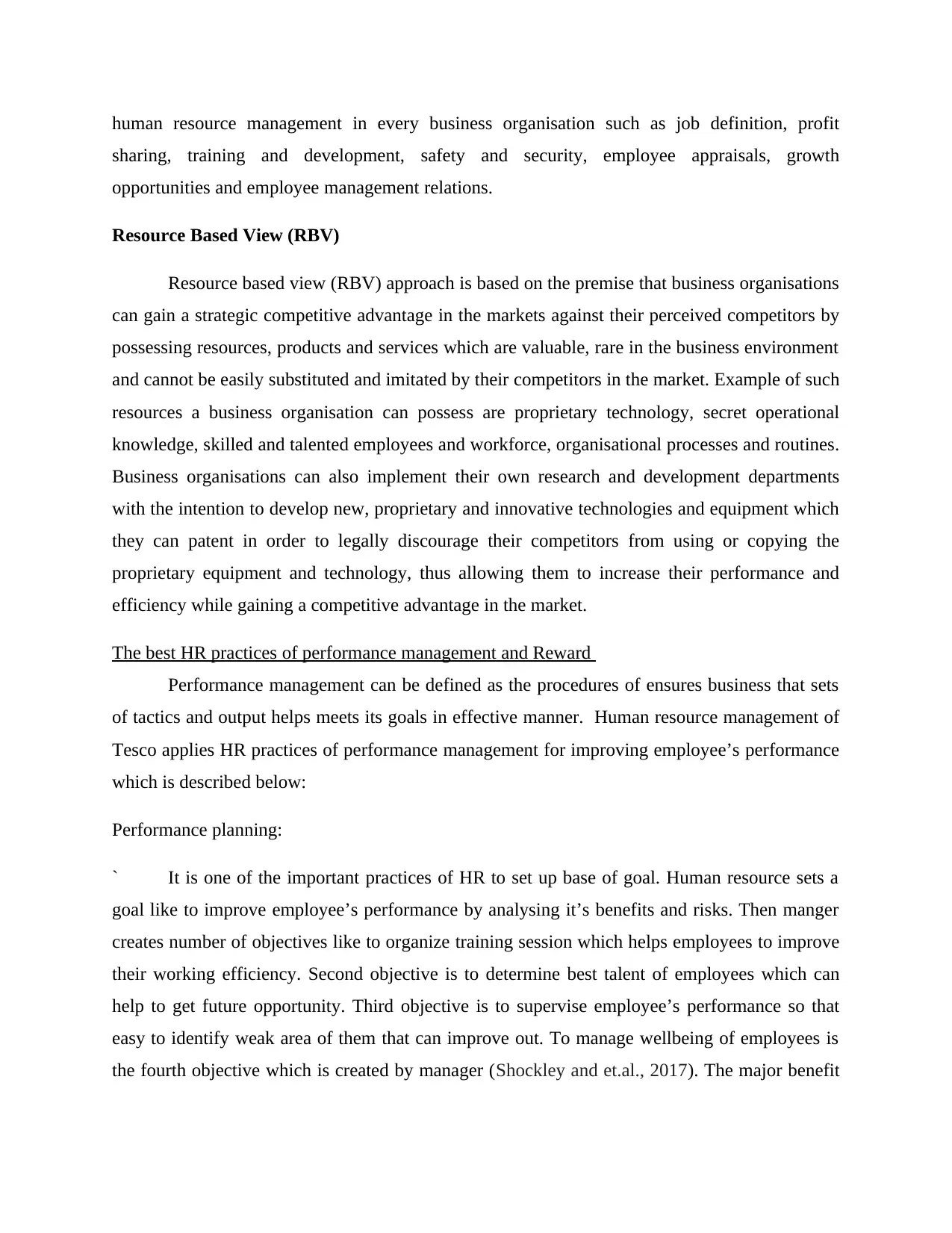
human resource management in every business organisation such as job definition, profit
sharing, training and development, safety and security, employee appraisals, growth
opportunities and employee management relations.
Resource Based View (RBV)
Resource based view (RBV) approach is based on the premise that business organisations
can gain a strategic competitive advantage in the markets against their perceived competitors by
possessing resources, products and services which are valuable, rare in the business environment
and cannot be easily substituted and imitated by their competitors in the market. Example of such
resources a business organisation can possess are proprietary technology, secret operational
knowledge, skilled and talented employees and workforce, organisational processes and routines.
Business organisations can also implement their own research and development departments
with the intention to develop new, proprietary and innovative technologies and equipment which
they can patent in order to legally discourage their competitors from using or copying the
proprietary equipment and technology, thus allowing them to increase their performance and
efficiency while gaining a competitive advantage in the market.
The best HR practices of performance management and Reward
Performance management can be defined as the procedures of ensures business that sets
of tactics and output helps meets its goals in effective manner. Human resource management of
Tesco applies HR practices of performance management for improving employee’s performance
which is described below:
Performance planning:
` It is one of the important practices of HR to set up base of goal. Human resource sets a
goal like to improve employee’s performance by analysing it’s benefits and risks. Then manger
creates number of objectives like to organize training session which helps employees to improve
their working efficiency. Second objective is to determine best talent of employees which can
help to get future opportunity. Third objective is to supervise employee’s performance so that
easy to identify weak area of them that can improve out. To manage wellbeing of employees is
the fourth objective which is created by manager (Shockley and et.al., 2017). The major benefit
sharing, training and development, safety and security, employee appraisals, growth
opportunities and employee management relations.
Resource Based View (RBV)
Resource based view (RBV) approach is based on the premise that business organisations
can gain a strategic competitive advantage in the markets against their perceived competitors by
possessing resources, products and services which are valuable, rare in the business environment
and cannot be easily substituted and imitated by their competitors in the market. Example of such
resources a business organisation can possess are proprietary technology, secret operational
knowledge, skilled and talented employees and workforce, organisational processes and routines.
Business organisations can also implement their own research and development departments
with the intention to develop new, proprietary and innovative technologies and equipment which
they can patent in order to legally discourage their competitors from using or copying the
proprietary equipment and technology, thus allowing them to increase their performance and
efficiency while gaining a competitive advantage in the market.
The best HR practices of performance management and Reward
Performance management can be defined as the procedures of ensures business that sets
of tactics and output helps meets its goals in effective manner. Human resource management of
Tesco applies HR practices of performance management for improving employee’s performance
which is described below:
Performance planning:
` It is one of the important practices of HR to set up base of goal. Human resource sets a
goal like to improve employee’s performance by analysing it’s benefits and risks. Then manger
creates number of objectives like to organize training session which helps employees to improve
their working efficiency. Second objective is to determine best talent of employees which can
help to get future opportunity. Third objective is to supervise employee’s performance so that
easy to identify weak area of them that can improve out. To manage wellbeing of employees is
the fourth objective which is created by manager (Shockley and et.al., 2017). The major benefit
Paraphrase This Document
Need a fresh take? Get an instant paraphrase of this document with our AI Paraphraser
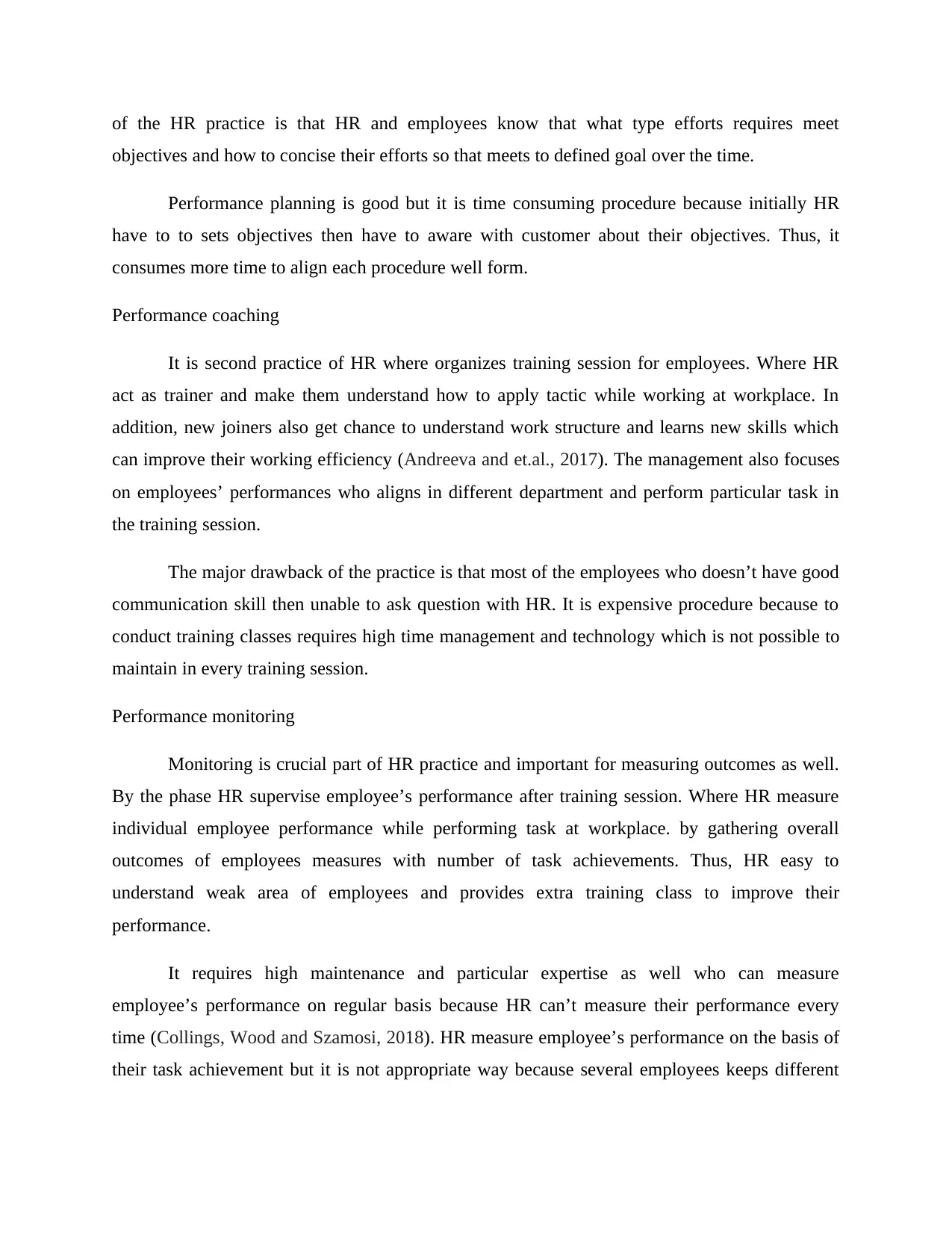
of the HR practice is that HR and employees know that what type efforts requires meet
objectives and how to concise their efforts so that meets to defined goal over the time.
Performance planning is good but it is time consuming procedure because initially HR
have to to sets objectives then have to aware with customer about their objectives. Thus, it
consumes more time to align each procedure well form.
Performance coaching
It is second practice of HR where organizes training session for employees. Where HR
act as trainer and make them understand how to apply tactic while working at workplace. In
addition, new joiners also get chance to understand work structure and learns new skills which
can improve their working efficiency (Andreeva and et.al., 2017). The management also focuses
on employees’ performances who aligns in different department and perform particular task in
the training session.
The major drawback of the practice is that most of the employees who doesn’t have good
communication skill then unable to ask question with HR. It is expensive procedure because to
conduct training classes requires high time management and technology which is not possible to
maintain in every training session.
Performance monitoring
Monitoring is crucial part of HR practice and important for measuring outcomes as well.
By the phase HR supervise employee’s performance after training session. Where HR measure
individual employee performance while performing task at workplace. by gathering overall
outcomes of employees measures with number of task achievements. Thus, HR easy to
understand weak area of employees and provides extra training class to improve their
performance.
It requires high maintenance and particular expertise as well who can measure
employee’s performance on regular basis because HR can’t measure their performance every
time (Collings, Wood and Szamosi, 2018). HR measure employee’s performance on the basis of
their task achievement but it is not appropriate way because several employees keeps different
objectives and how to concise their efforts so that meets to defined goal over the time.
Performance planning is good but it is time consuming procedure because initially HR
have to to sets objectives then have to aware with customer about their objectives. Thus, it
consumes more time to align each procedure well form.
Performance coaching
It is second practice of HR where organizes training session for employees. Where HR
act as trainer and make them understand how to apply tactic while working at workplace. In
addition, new joiners also get chance to understand work structure and learns new skills which
can improve their working efficiency (Andreeva and et.al., 2017). The management also focuses
on employees’ performances who aligns in different department and perform particular task in
the training session.
The major drawback of the practice is that most of the employees who doesn’t have good
communication skill then unable to ask question with HR. It is expensive procedure because to
conduct training classes requires high time management and technology which is not possible to
maintain in every training session.
Performance monitoring
Monitoring is crucial part of HR practice and important for measuring outcomes as well.
By the phase HR supervise employee’s performance after training session. Where HR measure
individual employee performance while performing task at workplace. by gathering overall
outcomes of employees measures with number of task achievements. Thus, HR easy to
understand weak area of employees and provides extra training class to improve their
performance.
It requires high maintenance and particular expertise as well who can measure
employee’s performance on regular basis because HR can’t measure their performance every
time (Collings, Wood and Szamosi, 2018). HR measure employee’s performance on the basis of
their task achievement but it is not appropriate way because several employees keeps different
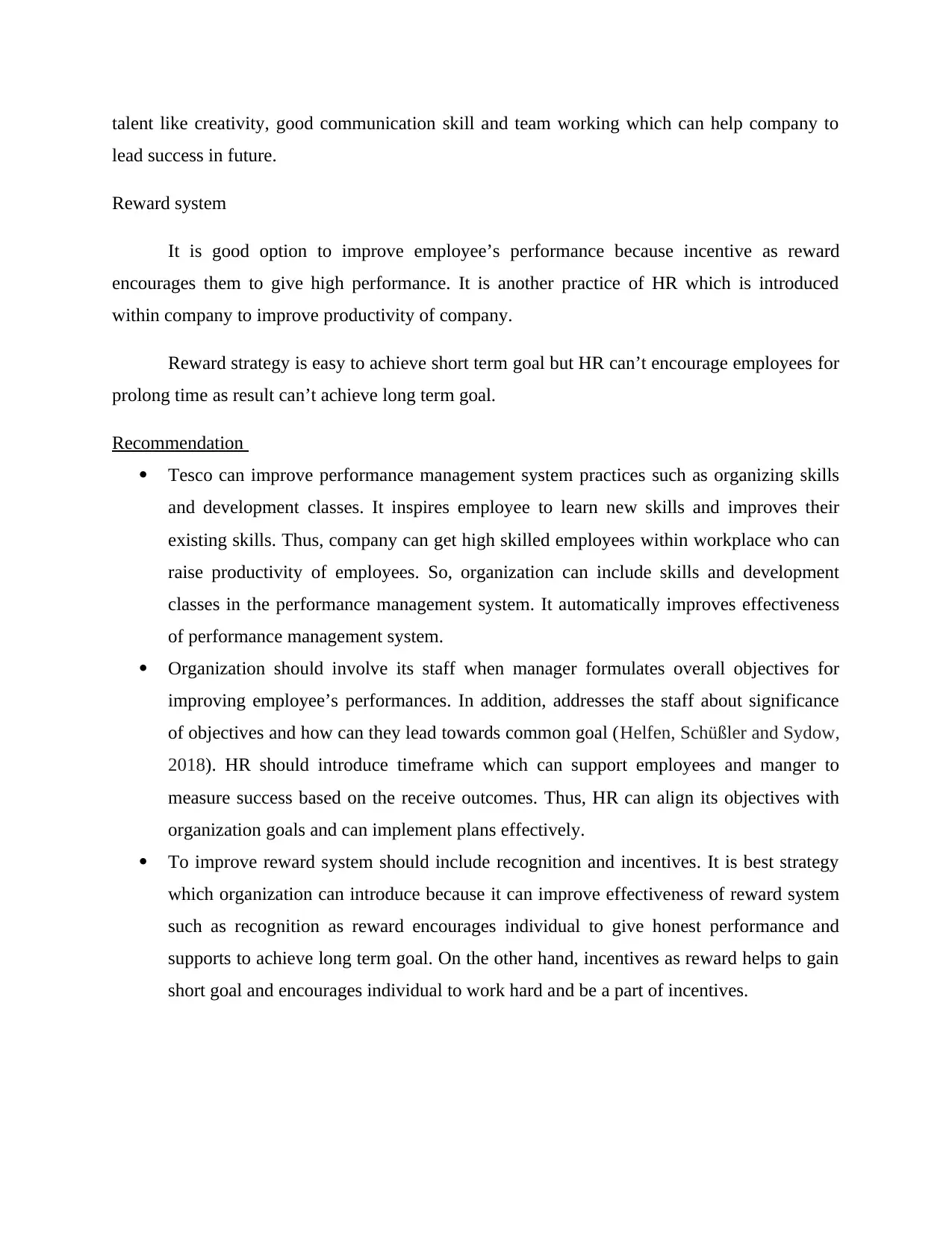
talent like creativity, good communication skill and team working which can help company to
lead success in future.
Reward system
It is good option to improve employee’s performance because incentive as reward
encourages them to give high performance. It is another practice of HR which is introduced
within company to improve productivity of company.
Reward strategy is easy to achieve short term goal but HR can’t encourage employees for
prolong time as result can’t achieve long term goal.
Recommendation
Tesco can improve performance management system practices such as organizing skills
and development classes. It inspires employee to learn new skills and improves their
existing skills. Thus, company can get high skilled employees within workplace who can
raise productivity of employees. So, organization can include skills and development
classes in the performance management system. It automatically improves effectiveness
of performance management system.
Organization should involve its staff when manager formulates overall objectives for
improving employee’s performances. In addition, addresses the staff about significance
of objectives and how can they lead towards common goal (Helfen, Schüßler and Sydow,
2018). HR should introduce timeframe which can support employees and manger to
measure success based on the receive outcomes. Thus, HR can align its objectives with
organization goals and can implement plans effectively.
To improve reward system should include recognition and incentives. It is best strategy
which organization can introduce because it can improve effectiveness of reward system
such as recognition as reward encourages individual to give honest performance and
supports to achieve long term goal. On the other hand, incentives as reward helps to gain
short goal and encourages individual to work hard and be a part of incentives.
lead success in future.
Reward system
It is good option to improve employee’s performance because incentive as reward
encourages them to give high performance. It is another practice of HR which is introduced
within company to improve productivity of company.
Reward strategy is easy to achieve short term goal but HR can’t encourage employees for
prolong time as result can’t achieve long term goal.
Recommendation
Tesco can improve performance management system practices such as organizing skills
and development classes. It inspires employee to learn new skills and improves their
existing skills. Thus, company can get high skilled employees within workplace who can
raise productivity of employees. So, organization can include skills and development
classes in the performance management system. It automatically improves effectiveness
of performance management system.
Organization should involve its staff when manager formulates overall objectives for
improving employee’s performances. In addition, addresses the staff about significance
of objectives and how can they lead towards common goal (Helfen, Schüßler and Sydow,
2018). HR should introduce timeframe which can support employees and manger to
measure success based on the receive outcomes. Thus, HR can align its objectives with
organization goals and can implement plans effectively.
To improve reward system should include recognition and incentives. It is best strategy
which organization can introduce because it can improve effectiveness of reward system
such as recognition as reward encourages individual to give honest performance and
supports to achieve long term goal. On the other hand, incentives as reward helps to gain
short goal and encourages individual to work hard and be a part of incentives.
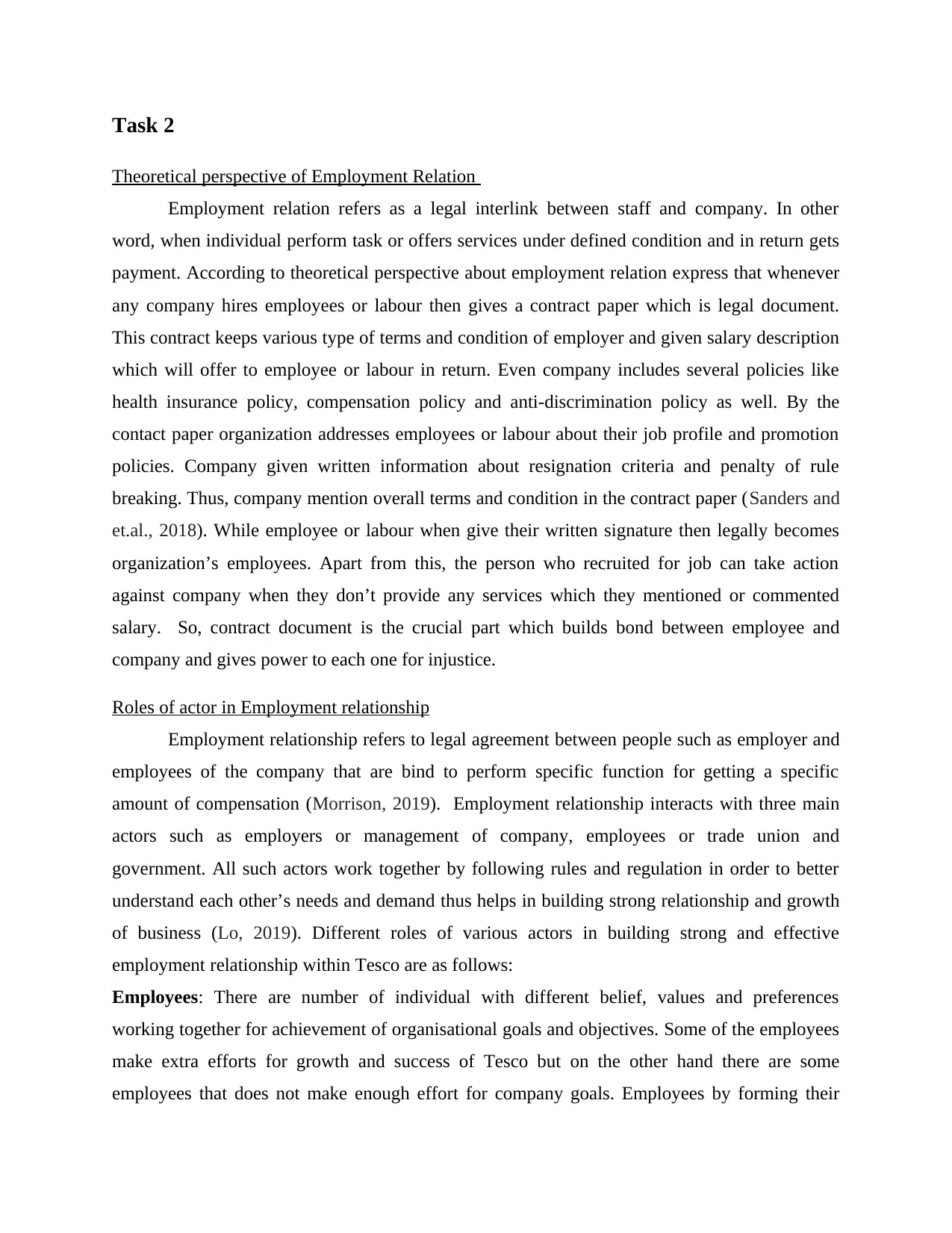
Task 2
Theoretical perspective of Employment Relation
Employment relation refers as a legal interlink between staff and company. In other
word, when individual perform task or offers services under defined condition and in return gets
payment. According to theoretical perspective about employment relation express that whenever
any company hires employees or labour then gives a contract paper which is legal document.
This contract keeps various type of terms and condition of employer and given salary description
which will offer to employee or labour in return. Even company includes several policies like
health insurance policy, compensation policy and anti-discrimination policy as well. By the
contact paper organization addresses employees or labour about their job profile and promotion
policies. Company given written information about resignation criteria and penalty of rule
breaking. Thus, company mention overall terms and condition in the contract paper (Sanders and
et.al., 2018). While employee or labour when give their written signature then legally becomes
organization’s employees. Apart from this, the person who recruited for job can take action
against company when they don’t provide any services which they mentioned or commented
salary. So, contract document is the crucial part which builds bond between employee and
company and gives power to each one for injustice.
Roles of actor in Employment relationship
Employment relationship refers to legal agreement between people such as employer and
employees of the company that are bind to perform specific function for getting a specific
amount of compensation (Morrison, 2019). Employment relationship interacts with three main
actors such as employers or management of company, employees or trade union and
government. All such actors work together by following rules and regulation in order to better
understand each other’s needs and demand thus helps in building strong relationship and growth
of business (Lo, 2019). Different roles of various actors in building strong and effective
employment relationship within Tesco are as follows:
Employees: There are number of individual with different belief, values and preferences
working together for achievement of organisational goals and objectives. Some of the employees
make extra efforts for growth and success of Tesco but on the other hand there are some
employees that does not make enough effort for company goals. Employees by forming their
Theoretical perspective of Employment Relation
Employment relation refers as a legal interlink between staff and company. In other
word, when individual perform task or offers services under defined condition and in return gets
payment. According to theoretical perspective about employment relation express that whenever
any company hires employees or labour then gives a contract paper which is legal document.
This contract keeps various type of terms and condition of employer and given salary description
which will offer to employee or labour in return. Even company includes several policies like
health insurance policy, compensation policy and anti-discrimination policy as well. By the
contact paper organization addresses employees or labour about their job profile and promotion
policies. Company given written information about resignation criteria and penalty of rule
breaking. Thus, company mention overall terms and condition in the contract paper (Sanders and
et.al., 2018). While employee or labour when give their written signature then legally becomes
organization’s employees. Apart from this, the person who recruited for job can take action
against company when they don’t provide any services which they mentioned or commented
salary. So, contract document is the crucial part which builds bond between employee and
company and gives power to each one for injustice.
Roles of actor in Employment relationship
Employment relationship refers to legal agreement between people such as employer and
employees of the company that are bind to perform specific function for getting a specific
amount of compensation (Morrison, 2019). Employment relationship interacts with three main
actors such as employers or management of company, employees or trade union and
government. All such actors work together by following rules and regulation in order to better
understand each other’s needs and demand thus helps in building strong relationship and growth
of business (Lo, 2019). Different roles of various actors in building strong and effective
employment relationship within Tesco are as follows:
Employees: There are number of individual with different belief, values and preferences
working together for achievement of organisational goals and objectives. Some of the employees
make extra efforts for growth and success of Tesco but on the other hand there are some
employees that does not make enough effort for company goals. Employees by forming their
Secure Best Marks with AI Grader
Need help grading? Try our AI Grader for instant feedback on your assignments.
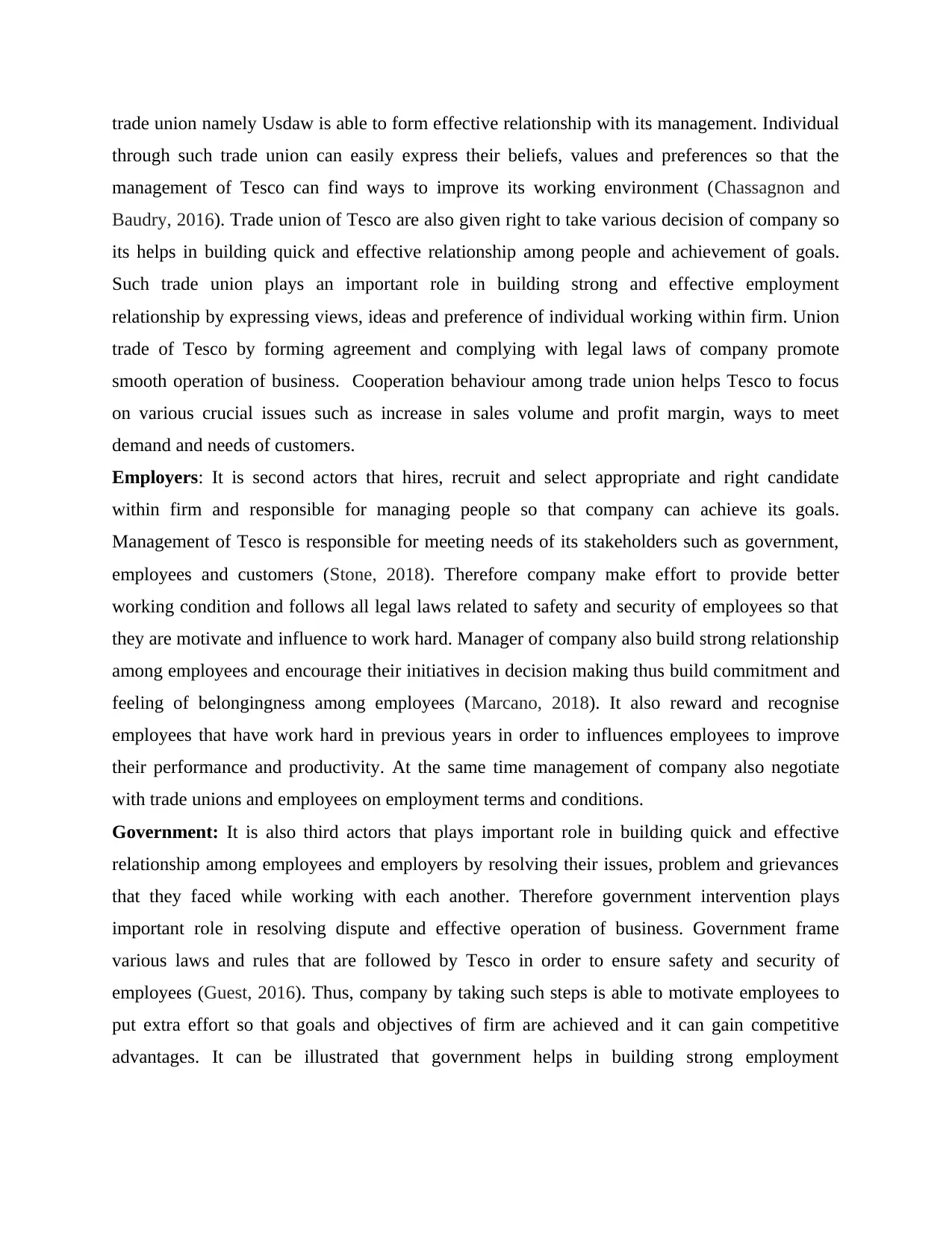
trade union namely Usdaw is able to form effective relationship with its management. Individual
through such trade union can easily express their beliefs, values and preferences so that the
management of Tesco can find ways to improve its working environment (Chassagnon and
Baudry, 2016). Trade union of Tesco are also given right to take various decision of company so
its helps in building quick and effective relationship among people and achievement of goals.
Such trade union plays an important role in building strong and effective employment
relationship by expressing views, ideas and preference of individual working within firm. Union
trade of Tesco by forming agreement and complying with legal laws of company promote
smooth operation of business. Cooperation behaviour among trade union helps Tesco to focus
on various crucial issues such as increase in sales volume and profit margin, ways to meet
demand and needs of customers.
Employers: It is second actors that hires, recruit and select appropriate and right candidate
within firm and responsible for managing people so that company can achieve its goals.
Management of Tesco is responsible for meeting needs of its stakeholders such as government,
employees and customers (Stone, 2018). Therefore company make effort to provide better
working condition and follows all legal laws related to safety and security of employees so that
they are motivate and influence to work hard. Manager of company also build strong relationship
among employees and encourage their initiatives in decision making thus build commitment and
feeling of belongingness among employees (Marcano, 2018). It also reward and recognise
employees that have work hard in previous years in order to influences employees to improve
their performance and productivity. At the same time management of company also negotiate
with trade unions and employees on employment terms and conditions.
Government: It is also third actors that plays important role in building quick and effective
relationship among employees and employers by resolving their issues, problem and grievances
that they faced while working with each another. Therefore government intervention plays
important role in resolving dispute and effective operation of business. Government frame
various laws and rules that are followed by Tesco in order to ensure safety and security of
employees (Guest, 2016). Thus, company by taking such steps is able to motivate employees to
put extra effort so that goals and objectives of firm are achieved and it can gain competitive
advantages. It can be illustrated that government helps in building strong employment
through such trade union can easily express their beliefs, values and preferences so that the
management of Tesco can find ways to improve its working environment (Chassagnon and
Baudry, 2016). Trade union of Tesco are also given right to take various decision of company so
its helps in building quick and effective relationship among people and achievement of goals.
Such trade union plays an important role in building strong and effective employment
relationship by expressing views, ideas and preference of individual working within firm. Union
trade of Tesco by forming agreement and complying with legal laws of company promote
smooth operation of business. Cooperation behaviour among trade union helps Tesco to focus
on various crucial issues such as increase in sales volume and profit margin, ways to meet
demand and needs of customers.
Employers: It is second actors that hires, recruit and select appropriate and right candidate
within firm and responsible for managing people so that company can achieve its goals.
Management of Tesco is responsible for meeting needs of its stakeholders such as government,
employees and customers (Stone, 2018). Therefore company make effort to provide better
working condition and follows all legal laws related to safety and security of employees so that
they are motivate and influence to work hard. Manager of company also build strong relationship
among employees and encourage their initiatives in decision making thus build commitment and
feeling of belongingness among employees (Marcano, 2018). It also reward and recognise
employees that have work hard in previous years in order to influences employees to improve
their performance and productivity. At the same time management of company also negotiate
with trade unions and employees on employment terms and conditions.
Government: It is also third actors that plays important role in building quick and effective
relationship among employees and employers by resolving their issues, problem and grievances
that they faced while working with each another. Therefore government intervention plays
important role in resolving dispute and effective operation of business. Government frame
various laws and rules that are followed by Tesco in order to ensure safety and security of
employees (Guest, 2016). Thus, company by taking such steps is able to motivate employees to
put extra effort so that goals and objectives of firm are achieved and it can gain competitive
advantages. It can be illustrated that government helps in building strong employment
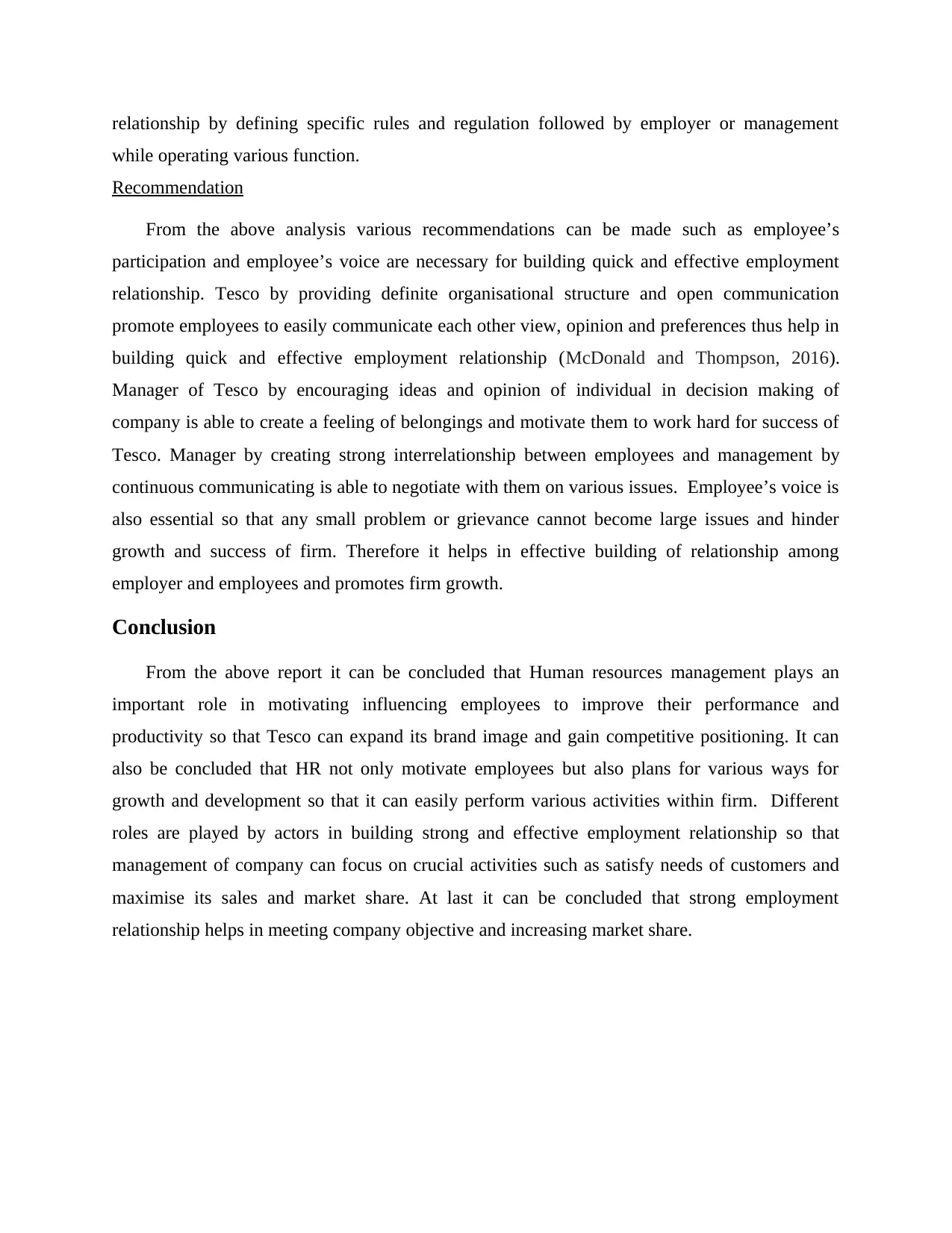
relationship by defining specific rules and regulation followed by employer or management
while operating various function.
Recommendation
From the above analysis various recommendations can be made such as employee’s
participation and employee’s voice are necessary for building quick and effective employment
relationship. Tesco by providing definite organisational structure and open communication
promote employees to easily communicate each other view, opinion and preferences thus help in
building quick and effective employment relationship (McDonald and Thompson, 2016).
Manager of Tesco by encouraging ideas and opinion of individual in decision making of
company is able to create a feeling of belongings and motivate them to work hard for success of
Tesco. Manager by creating strong interrelationship between employees and management by
continuous communicating is able to negotiate with them on various issues. Employee’s voice is
also essential so that any small problem or grievance cannot become large issues and hinder
growth and success of firm. Therefore it helps in effective building of relationship among
employer and employees and promotes firm growth.
Conclusion
From the above report it can be concluded that Human resources management plays an
important role in motivating influencing employees to improve their performance and
productivity so that Tesco can expand its brand image and gain competitive positioning. It can
also be concluded that HR not only motivate employees but also plans for various ways for
growth and development so that it can easily perform various activities within firm. Different
roles are played by actors in building strong and effective employment relationship so that
management of company can focus on crucial activities such as satisfy needs of customers and
maximise its sales and market share. At last it can be concluded that strong employment
relationship helps in meeting company objective and increasing market share.
while operating various function.
Recommendation
From the above analysis various recommendations can be made such as employee’s
participation and employee’s voice are necessary for building quick and effective employment
relationship. Tesco by providing definite organisational structure and open communication
promote employees to easily communicate each other view, opinion and preferences thus help in
building quick and effective employment relationship (McDonald and Thompson, 2016).
Manager of Tesco by encouraging ideas and opinion of individual in decision making of
company is able to create a feeling of belongings and motivate them to work hard for success of
Tesco. Manager by creating strong interrelationship between employees and management by
continuous communicating is able to negotiate with them on various issues. Employee’s voice is
also essential so that any small problem or grievance cannot become large issues and hinder
growth and success of firm. Therefore it helps in effective building of relationship among
employer and employees and promotes firm growth.
Conclusion
From the above report it can be concluded that Human resources management plays an
important role in motivating influencing employees to improve their performance and
productivity so that Tesco can expand its brand image and gain competitive positioning. It can
also be concluded that HR not only motivate employees but also plans for various ways for
growth and development so that it can easily perform various activities within firm. Different
roles are played by actors in building strong and effective employment relationship so that
management of company can focus on crucial activities such as satisfy needs of customers and
maximise its sales and market share. At last it can be concluded that strong employment
relationship helps in meeting company objective and increasing market share.

Paraphrase This Document
Need a fresh take? Get an instant paraphrase of this document with our AI Paraphraser
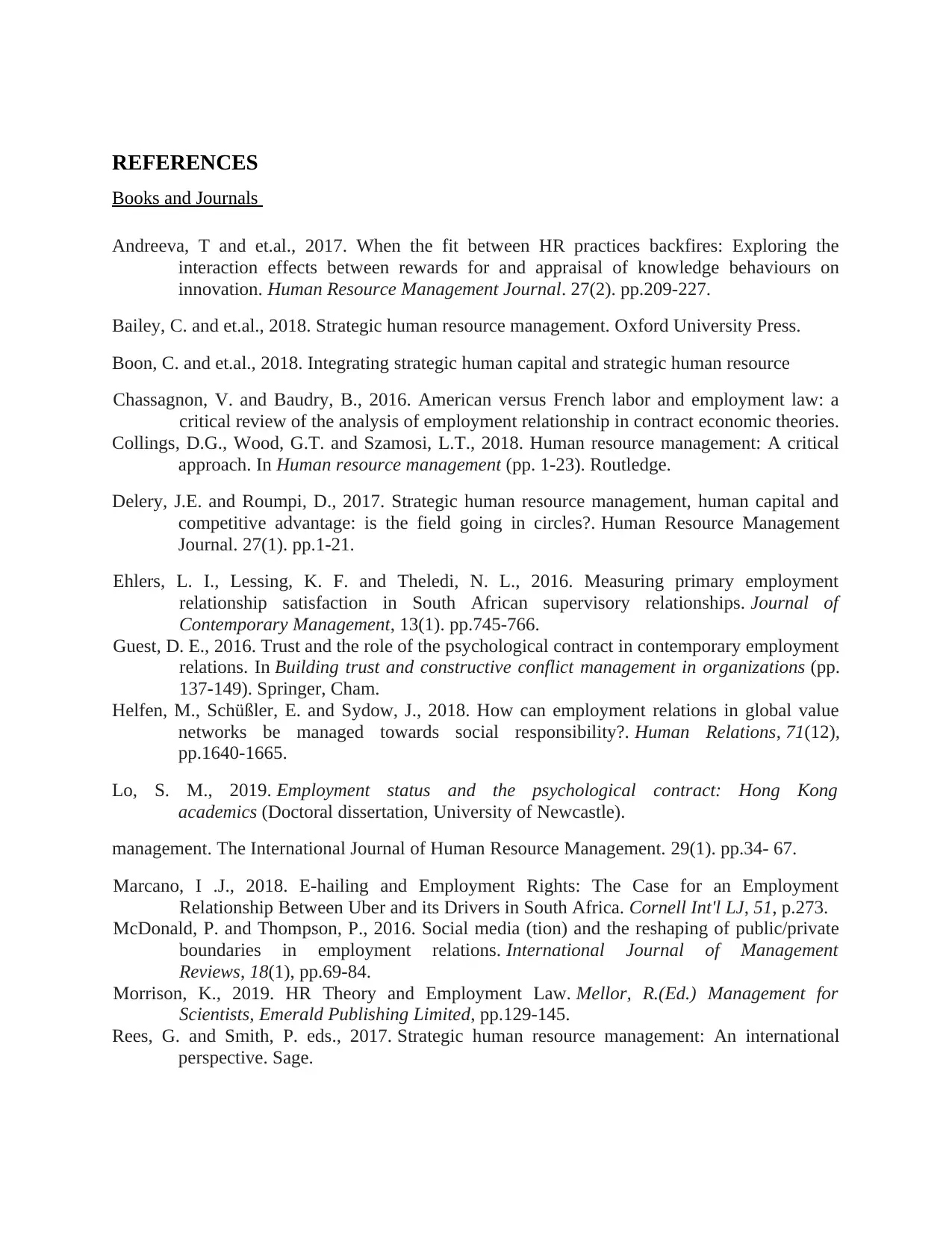
REFERENCES
Books and Journals
Andreeva, T and et.al., 2017. When the fit between HR practices backfires: Exploring the
interaction effects between rewards for and appraisal of knowledge behaviours on
innovation. Human Resource Management Journal. 27(2). pp.209-227.
Bailey, C. and et.al., 2018. Strategic human resource management. Oxford University Press.
Boon, C. and et.al., 2018. Integrating strategic human capital and strategic human resource
Chassagnon, V. and Baudry, B., 2016. American versus French labor and employment law: a
critical review of the analysis of employment relationship in contract economic theories.
Collings, D.G., Wood, G.T. and Szamosi, L.T., 2018. Human resource management: A critical
approach. In Human resource management (pp. 1-23). Routledge.
Delery, J.E. and Roumpi, D., 2017. Strategic human resource management, human capital and
competitive advantage: is the field going in circles?. Human Resource Management
Journal. 27(1). pp.1-21.
Ehlers, L. I., Lessing, K. F. and Theledi, N. L., 2016. Measuring primary employment
relationship satisfaction in South African supervisory relationships. Journal of
Contemporary Management, 13(1). pp.745-766.
Guest, D. E., 2016. Trust and the role of the psychological contract in contemporary employment
relations. In Building trust and constructive conflict management in organizations (pp.
137-149). Springer, Cham.
Helfen, M., Schüßler, E. and Sydow, J., 2018. How can employment relations in global value
networks be managed towards social responsibility?. Human Relations, 71(12),
pp.1640-1665.
Lo, S. M., 2019. Employment status and the psychological contract: Hong Kong
academics (Doctoral dissertation, University of Newcastle).
management. The International Journal of Human Resource Management. 29(1). pp.34- 67.
Marcano, I .J., 2018. E-hailing and Employment Rights: The Case for an Employment
Relationship Between Uber and its Drivers in South Africa. Cornell Int'l LJ, 51, p.273.
McDonald, P. and Thompson, P., 2016. Social media (tion) and the reshaping of public/private
boundaries in employment relations. International Journal of Management
Reviews, 18(1), pp.69-84.
Morrison, K., 2019. HR Theory and Employment Law. Mellor, R.(Ed.) Management for
Scientists, Emerald Publishing Limited, pp.129-145.
Rees, G. and Smith, P. eds., 2017. Strategic human resource management: An international
perspective. Sage.
Books and Journals
Andreeva, T and et.al., 2017. When the fit between HR practices backfires: Exploring the
interaction effects between rewards for and appraisal of knowledge behaviours on
innovation. Human Resource Management Journal. 27(2). pp.209-227.
Bailey, C. and et.al., 2018. Strategic human resource management. Oxford University Press.
Boon, C. and et.al., 2018. Integrating strategic human capital and strategic human resource
Chassagnon, V. and Baudry, B., 2016. American versus French labor and employment law: a
critical review of the analysis of employment relationship in contract economic theories.
Collings, D.G., Wood, G.T. and Szamosi, L.T., 2018. Human resource management: A critical
approach. In Human resource management (pp. 1-23). Routledge.
Delery, J.E. and Roumpi, D., 2017. Strategic human resource management, human capital and
competitive advantage: is the field going in circles?. Human Resource Management
Journal. 27(1). pp.1-21.
Ehlers, L. I., Lessing, K. F. and Theledi, N. L., 2016. Measuring primary employment
relationship satisfaction in South African supervisory relationships. Journal of
Contemporary Management, 13(1). pp.745-766.
Guest, D. E., 2016. Trust and the role of the psychological contract in contemporary employment
relations. In Building trust and constructive conflict management in organizations (pp.
137-149). Springer, Cham.
Helfen, M., Schüßler, E. and Sydow, J., 2018. How can employment relations in global value
networks be managed towards social responsibility?. Human Relations, 71(12),
pp.1640-1665.
Lo, S. M., 2019. Employment status and the psychological contract: Hong Kong
academics (Doctoral dissertation, University of Newcastle).
management. The International Journal of Human Resource Management. 29(1). pp.34- 67.
Marcano, I .J., 2018. E-hailing and Employment Rights: The Case for an Employment
Relationship Between Uber and its Drivers in South Africa. Cornell Int'l LJ, 51, p.273.
McDonald, P. and Thompson, P., 2016. Social media (tion) and the reshaping of public/private
boundaries in employment relations. International Journal of Management
Reviews, 18(1), pp.69-84.
Morrison, K., 2019. HR Theory and Employment Law. Mellor, R.(Ed.) Management for
Scientists, Emerald Publishing Limited, pp.129-145.
Rees, G. and Smith, P. eds., 2017. Strategic human resource management: An international
perspective. Sage.
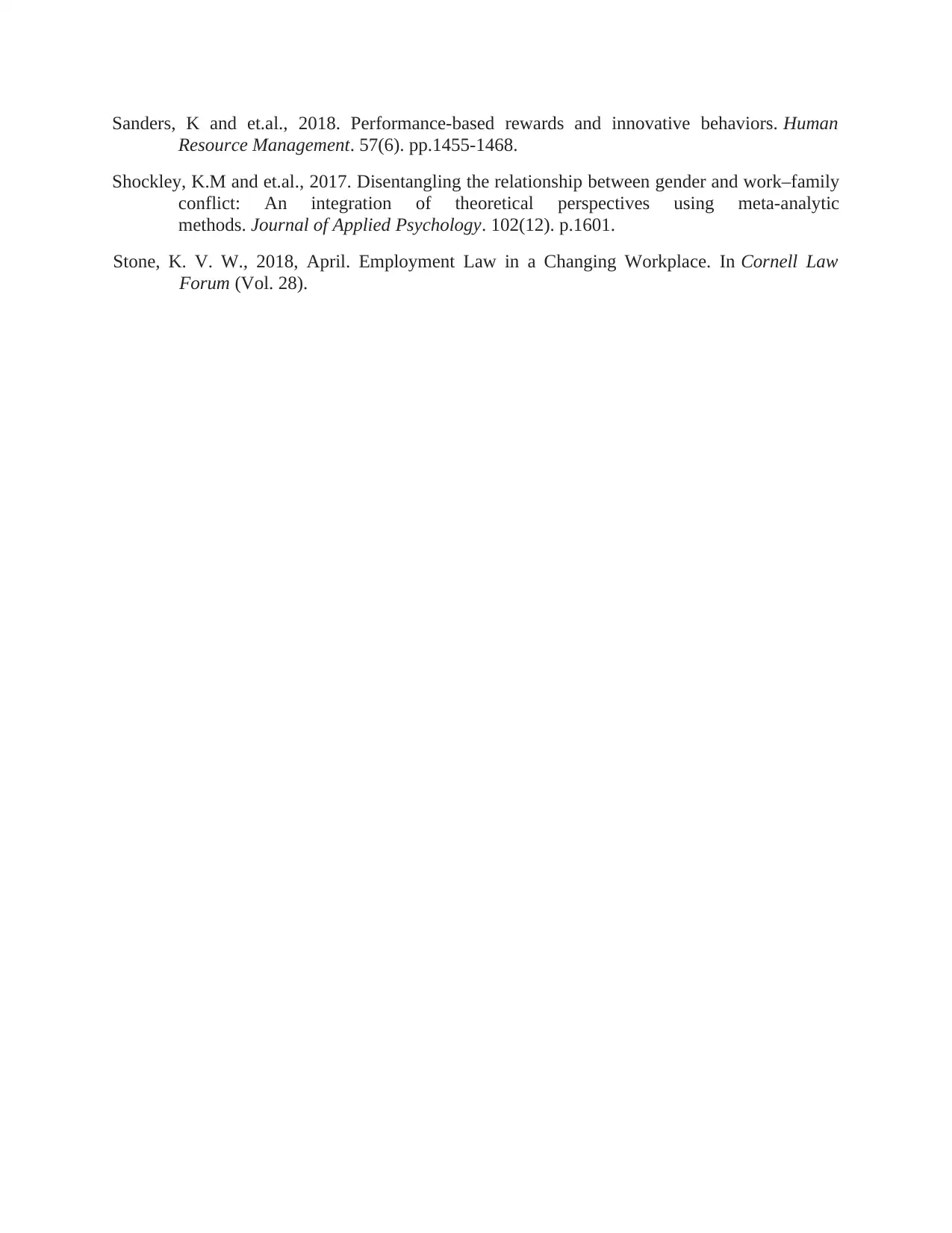
Sanders, K and et.al., 2018. Performance‐based rewards and innovative behaviors. Human
Resource Management. 57(6). pp.1455-1468.
Shockley, K.M and et.al., 2017. Disentangling the relationship between gender and work–family
conflict: An integration of theoretical perspectives using meta-analytic
methods. Journal of Applied Psychology. 102(12). p.1601.
Stone, K. V. W., 2018, April. Employment Law in a Changing Workplace. In Cornell Law
Forum (Vol. 28).
Resource Management. 57(6). pp.1455-1468.
Shockley, K.M and et.al., 2017. Disentangling the relationship between gender and work–family
conflict: An integration of theoretical perspectives using meta-analytic
methods. Journal of Applied Psychology. 102(12). p.1601.
Stone, K. V. W., 2018, April. Employment Law in a Changing Workplace. In Cornell Law
Forum (Vol. 28).
1 out of 15
Related Documents
Your All-in-One AI-Powered Toolkit for Academic Success.
+13062052269
info@desklib.com
Available 24*7 on WhatsApp / Email
![[object Object]](/_next/static/media/star-bottom.7253800d.svg)
Unlock your academic potential
© 2024 | Zucol Services PVT LTD | All rights reserved.





